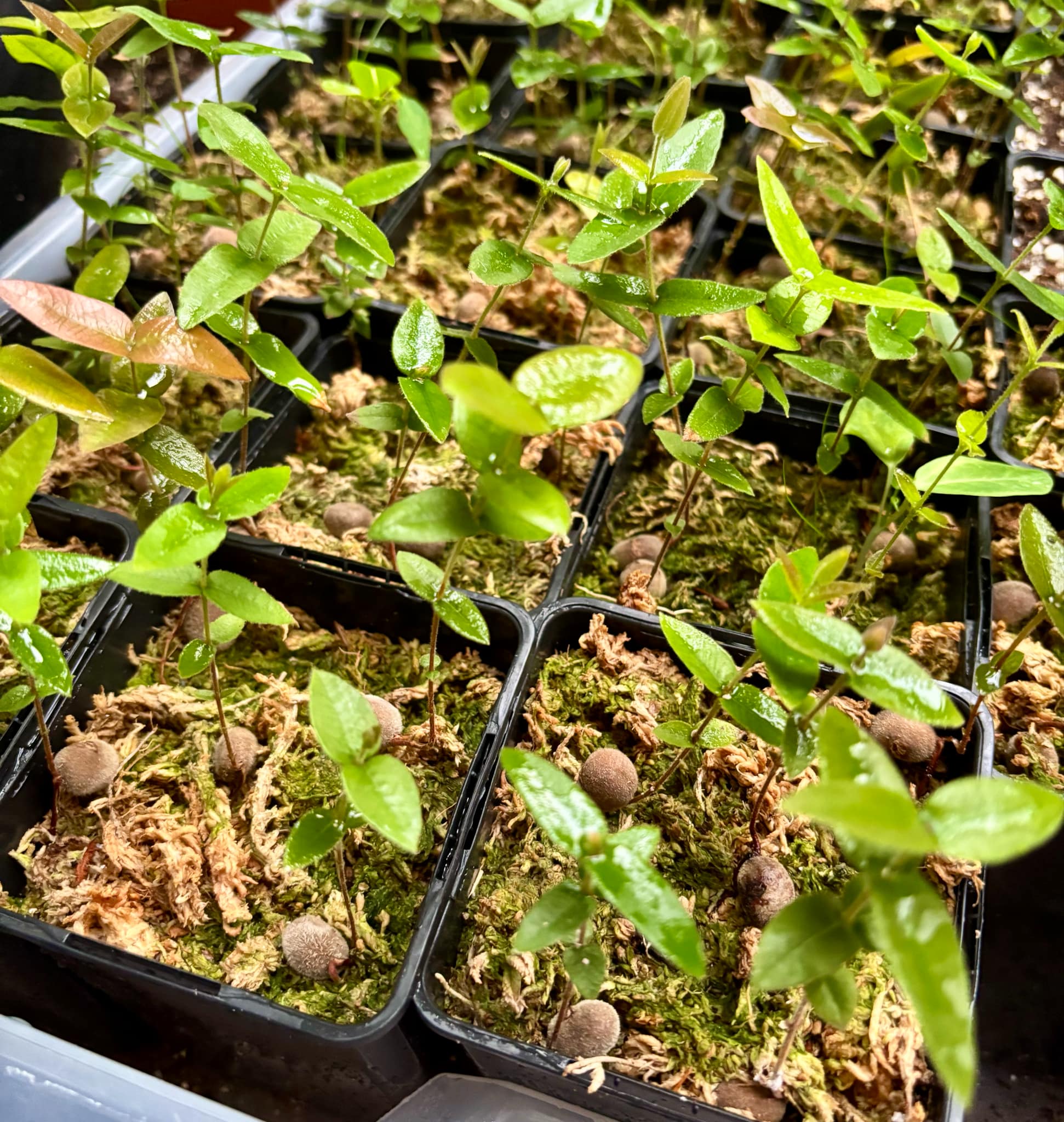Myrciaria caerulescens (Roxa - Blue Guaquiea) - 1 potted seedling / 1 kleiner, getopfter Sämling
Myrciaria caerulescens (Roxa - Blue Guaquiea)
Family / Familie: Myrtaceae
origin from / Herkunft: Brasil / Brasilien
Climate / Klima: temperate to warm (15-30C / 59-86F) / gemäßigt bis warm (15-30C / 59-86F)
Use / Verwendung: edible fruits, juice, jam, ice cream, etc. / essbare Früchte, Säfte, Marmelade, Eis usw.
you buy / sie kaufen: 1 potted seedling / 1 kleiner, getopfter Sämling
Delivery EU only
Important Notice
The plant can grow for over two years in sphagnum moss alone. After about two years, the sphagnum moss decomposes and slowly turns into soil.
This gives the roots time to slowly acclimate to the soil's components, allowing the plant to grow quickly and without problems.
If this seedling were potted in soil from the beginning, the roots would burn, and the plant would grow slowly or not at all.
This would happen because the soil in the original location is very poor and washed out.
Introduction
Myrciaria caerulescens – formerly known as Myrciaria sp. roxa or Blue Guaquiea – is a fascinating discovery among exotic fruit plants.
In 2024, it finally received its scientific name. Its fruits are said to taste even better than those of the popular Jaboticaba.
Origin and Habitat
Native to the Caetité region in the Brazilian state of Bahia, where the climate is warm and features a distinct dry season.
The local soil is rich in iron and contains a high percentage of quartz sand.
Cultivation and Care
-
Fertilization: No fertilizer needed or recommended.
-
Light: Prefers a bright location without harsh midday sun.
-
Temperature: Keep above 15 °C (59 °F) during winter.
-
Growth: Slow initial growth; later forms a compact shrub, perfect for container growing.
Special Features
-
Fruit: Outstanding flavor – reportedly even better than Jaboticaba.
-
History: From the "Blue Guaquiea" to the officially described Myrciaria caerulescens – a plant with history.
Practical Tip
One of our plants thrived healthily for over two years exclusively in pure sphagnum moss.
Wichtiger Hinweis
Die Pflanze kann über zwei Jahre nur in Sphagnum Moos wachsen. Nach ungefähr 2 Jahren verrottet das Sphagnum Moos und wird langsam zu Erde.
Dadurch haben die Wurzeln Zeit sich langsam an die Bestandteile der Erde zu gewöhnen und die Pflanze wird zügig und ohne Probleme wachsen.
Würde man diesen Sämling von Anfang an in Erde topfen, würden die Wurzeln "verbrennen" und die Pflanze würde nur langsam oder gar nicht wachsen.
Dies würde passieren weil die Erde am Originalstandort sehr mager und ausgewaschen ist.
Einführung
Die Myrciaria caerulescens – früher bekannt als Myrciaria sp. roxa oder Blue Guaquiea – ist eine faszinierende Entdeckung unter den exotischen Fruchtpflanzen.
Im Jahr 2024 erhielt sie endlich ihren wissenschaftlichen Namen.
Der Geschmack ihrer Früchte soll die beliebte Jaboticaba sogar übertreffen.
Herkunft und Standort
Die Heimat der Pflanze ist die Region Caetité im brasilianischen Bundesstaat Bahia, wo ein warmes Klima und eine ausgeprägte Trockenzeit herrschen.
Der Boden dort ist eisenhaltig und enthält viel Quarzsand.
Kultur und Pflege
-
Düngung: Kein Dünger erforderlich oder empfohlen.
-
Licht: Ein heller Standort ohne direkte Mittagssonne ist ideal.
-
Temperatur: Überwinterung bei mindestens 15 °C.
-
Wachstum: Anfangs langsames Wachstum; später kompakter Strauch, sehr gut für die Kübelkultur geeignet.
Besondere Eigenschaften
-
Frucht: Hervorragender Geschmack – noch besser als Jaboticaba.
-
Geschichte: Vom "Blue Guaquiea" zum offiziell beschriebenen Myrciaria caerulescens – eine Pflanze mit Geschichte.
Praxistipp
Eine Pflanze aus unserer Anzucht wuchs über zwei Jahre problemlos und gesund nur in reinem Sphagnum Moos.







